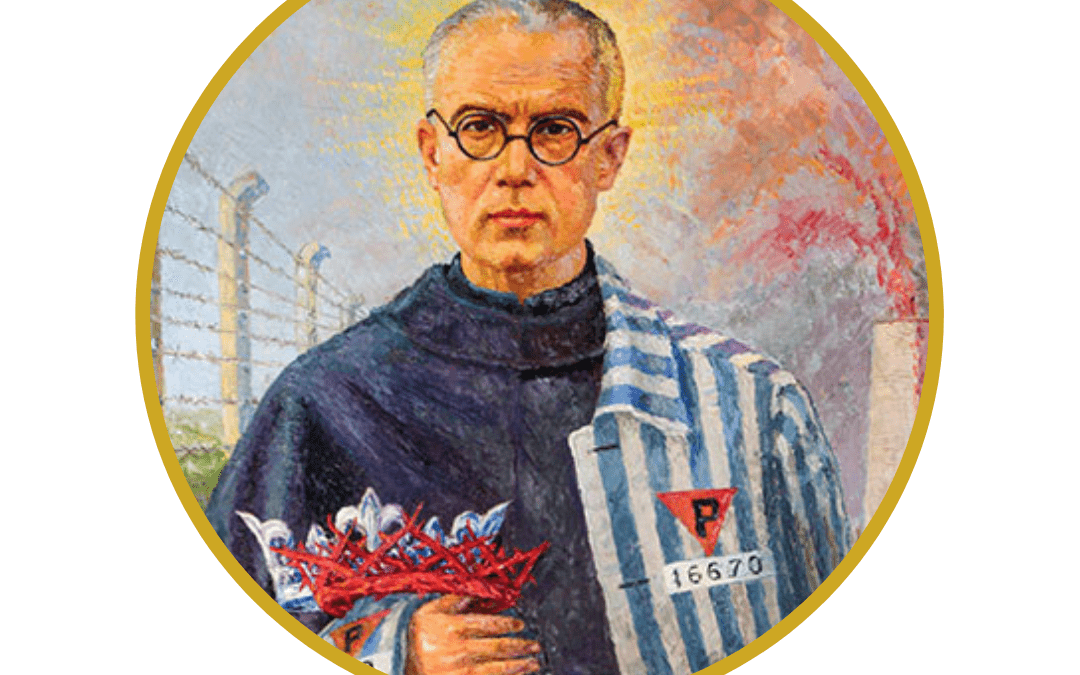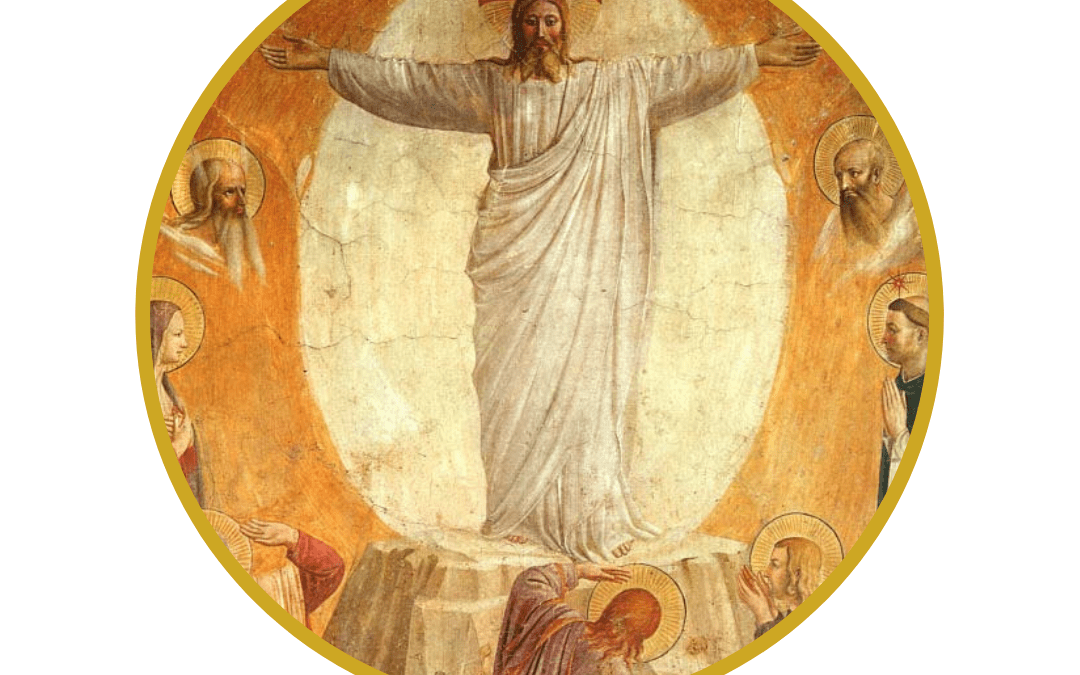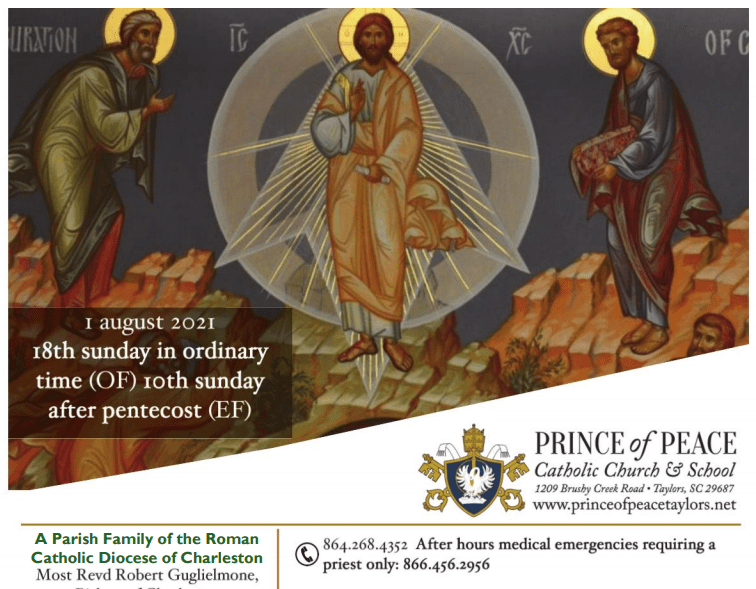
by popadmin | Aug 2, 2021 | CIC Saint Writeups
Saint Maximilian was born Raymond Kolbe in Poland in 1894. As a youth, he had a vision from the Blessed Mother. He described it best himself: “That night, I asked the Mother of God what was to become of me. Then she came to me holding two crowns, one white, the other red. She asked me if I was willing to accept either of these crowns. The white one meant that I should persevere in purity, and the red that I should become a martyr. I said that I would accept them both.” In 1910, he entered the novitiate of Conventual Franciscan Order and was given the name Maximilian. He was sent to study in Rome where he was ordained a priest in 1918. After returning to Poland in 1920, he wrote: “I must be a saint, the greatest saint possible. Remember that you are the absolute, unconditional, unlimited, irrevocable property of the Immaculate… My life, my death and my eternity are yours, O Immaculate. Do with me whatever you wish.” Back in Poland, Father Maximilian organized his Militia of the Immaculate Virgin Mary – a movement of Marian consecration. In 1922, he published the magazine, “Knight of the Immaculate” to promote devotion to Mary. In 1927, he built a town called the “Town of the Immaculate,” outside of Warsaw. There he trained ‘apostles of Mary’. By 1939, the City had expanded from 18 friars to 650, making it the world’s largest Catholic religious house. To better “win the world for the Immaculata,” the friars utilized modern printing techniques. They published countless catechetical and devotional tracts, a daily newspaper and a monthly magazine with a circulation of over one million. Maximilian started a shortwave radio station –he was a true “apostle of the mass media.” He was also a ground-breaking theologian. His insights into the Immaculate Conception developed understanding of Mary as “Mediatrix” of all graces and as “Advocate” for God’s people. In 1941, the Nazis imprisoned Father Maximilian in Auschwitz. In July, it was reported to the camp commander that a prisoner had escaped. In order to set an example, they selected ten men for the starvation bunker. When a man near him was chosen, a man who cried in protest because he had a family, Maximilian bravely stepped forward and said “Let me take the place of this man. I am a Catholic priest.” Maximilian was taken to endure an excruciatingly slow death. On August 14, 1941, the vigil of the Assumption of the Blessed Virgin Mary, Father Maximilian’s two-week ordeal in the starvation bunker was brought to an end by an injection of carbolic acid. Of the ten victims, he was the last to die. “Hail Mary!” was the last prayer on the lips of Father Maximilian, as he offered his arm to the person injecting the acid. In 1982, Saint JP II canonized Maximilian Kolbe as a “martyr of charity.” Saint Maximilian Kolbe is considered a patron of journalists, families, prisoners, the pro-life movement and the chemically addicted.
“Greater love has no man than this, that a man lay down his life for his friends” (John 15:12)
Ideas for celebrating this feast at home:
- In honor of this Polish saint, make Polish recipes for dinner. Ideas: Kielbasa Stew or Polish Kielbasa and Pierogies Sheet Pan Meal. For dessert, Polish Lemon Babka or Polish Cream Cheese Cookies (“Kolaczki”). OR, make two cakes, one red and one white, to symbolize the two crowns that Maximilian accepted.
- Watch the movie Maximilian: Saint of Auschwitz available on FORMED (ages 10+).
- For younger children, watch the Lukas Storyteller video Saint Maximilian Kolbe, also on FORMED.
- Children may enjoy crafting homemade red and white “crowns” (use construction paper and stickers or glitter, etc!) to wear at dinner and discuss what it means to live out the virtue of purity and to be called to martyrdom. Encourage each other to always be open to God’s calling in our lives.
- Offer a Mass, say a rosary, pray for those who suffer in the world today from man’s inhumanity. Pray for an end to abortion, our nation’s own holocaust. Be a living witness to the culture of life.
(sources: catholicculture.org; saintmaxmiliankolbe.com; showerofrosesblog.com)

by popadmin | Aug 1, 2021 | CIC Saint Writeups
6 August: Feast of the Transfiguration of the Lord. The Transfiguration is one of the major events in the earthly life of Jesus. The gospels tell the story of Jesus bringing Saint Peter and the two sons of Zebedee, Sts. James and John, up to the top of a high mountain to pray (tradition holds that it was Mount Tabor). This would have been about a year before Our Lord’s passion. While he was praying, Jesus’ appearance changed and his clothing became dazzling white: “His face shone like the sun, and his garments became white as light” (Mt 17:2). Next, Moses and Elijah appeared in glory and spoke with Jesus of things that were to come. The disciples were amazed and overwhelmed. Unsure what to do, St. Peter offered to put up tents for Jesus and his friends. Although they had been with Jesus for three years, the disciples still did not really understand who He was. Then, a cloud overshadowed them. They became frightened and heard a voice from Heaven saying: “This is my beloved Son, with whom I am well pleased; listen to him.” (Mt 17:5). After Moses and Elijah disappeared, Jesus instructed the disciples not to tell anyone about this “until the Son of man has been raised from the dead” (Mt 17:9). This event, called the Transfiguration, is significant in the Christian faith. Saint Thomas Aquinas called it “the greatest miracle” because it revealed the divinity of Christ before his passion and death. In the Transfiguration, Christ enjoyed for a short while that glorified state which was to be permanently His after the Resurrection. The splendor of His inward Divinity and of the Beatific Vision of His soul overflowed on His body, and permeated His garments so that Christ stood before Peter, James, and John in a snow-white brightness. This feast day became widespread in the West in the 11th century and was introduced into the Roman calendar in 1457 to commemorate the victory over Islam in Belgrade. Before that, the Transfiguration of the Lord was celebrated in the Syrian, Byzantine, and Coptic rites. The Transfiguration foretells the glory of the Lord as God, and His Ascension into heaven. It anticipates the glory of heaven, where we shall see God face to face, in all of His dazzling glory.
Ideas for celebrating this feast day at home:
- Pray a decade of the Luminous mysteries together as a family—the Transfiguration, of course!
- In the Scriptures, mountains are often portrayed as sacred places where humans meet God. (Think of Moses on Mt. Sinai and Elijah on Mt. Horeb.) If you can, take a mountain hike today and spend some time in quiet prayer and reflection.
- Celebrate this feast day with all things WHITE! Wear white clothing; set the dinner table with a white tablecloth and white candles; cook and eat lots of white foods to recall how Jesus’ face “shone like the sun and his clothes became white as light” (Mt. 17:2).
- Ideas: egg white omelets and biscuits for breakfast; fettuccine alfredo or white fish with mashed potatoes or white rice for dinner. Dessert could be meringue cookies; Mexican wedding cakes; or angel food cake with vanilla ice cream or homemade whipped cream. (Heavy cream is ‘transformed’ when you whip it up with a bit of sugar. This is a fun hands-on activity to do with children to bring to mind the Transfiguration!) OR, simply ‘transform’ leftover food into a new dinner to celebrate this transformative feast day.
- With tradition holding that the Pope presses ripe grapes into the chalice at Mass or uses new wine on this feast, don’t forget to enjoy a bottle of sparkling grape juice or red wine at supper tonight! (The symbolism here is the transformation: fruit develops from bud, to flower, to ripened fruit which is a natural transfiguration. Then, the grapes continue to be transformed from fruit, to juice, to wine, and then sacramentally, to the Blood of Christ received in the Eucharist.)
- View some paintings of the Transfiguration here.
- Here are some Transfiguration worksheets for kids to enjoy:
- Transfiguration maze
- Transfiguration word search and word jumble
- Transfiguration coloring pages

by popadmin | Aug 1, 2021 | Bulletin
Click to read this week’s bulletin: 1 August 2021
by popadmin | Jul 14, 2021 | CIC Saint Writeups
26 July: Feast Day of Saints Anne and Joachim. Saints Anne and Joachim are honored by the church as the parents of the Blessed Virgin Mary and the grandparents of Jesus. Not much is known about these special grandparents; what we do know about them comes through tradition. We believe that they were respected members of the Jewish community, and that they wanted to become parents so much that Joachim went into the desert to fast and pray for this intention. An angel told them they would soon have a daughter who would become famous throughout the world. Months later, Mary was born. When she was three years old, Anne and Joachim took her to the temple in Jerusalem to consecrate her for service to the Lord. This is celebrated in the church as the “Presentation of the Blessed Virgin Mary.” We know little else about the lives of Mary’s parents, but considering the person of Mary, they must have been two very remarkable people to have been given such a daughter and to have played so important a part in the work of the Redemption. Thus, we honor Mary’s parents as saints who brought Mary up to be the most worthy Mother of God. It was Anne and Joachim who taught Mary to have faith in God and who showed Mary the example of godly parenting. Anne and Joachim’s love for one another and for Mary is an example of how God calls us to live. Today, the church honors the grandparents of Jesus. This is the perfect reminder for us to honor our own parents and grandparents and to thank them for the blessings they have passed down to us. Saint Anne is the patron of childless couples, mothers, grandmothers, grandparents, homemakers, pregnancy, women in labor, and others. Saint Joachim is the patron saint of fathers, grandfathers, and grandparents.
2021 World Day for Grandparents and the Elderly – Papal Decree on the Granting of Indulgence:
The Apostolic Penitentiary, in order to increase the devotion of the faithful and for the salvation of souls, by virtue of the faculties attributed to it by the Supreme Pontiff Pope Francis by Divine Providence on the occasion of the First World Day of Grandparents and the Elderly, recently instituted by the Supreme Pontiff on the fourth Sunday of the month of July, graciously grants the Plenary Indulgence, under the usual conditions (sacramental confession, Eucharistic communion and prayer according to the intentions of the Supreme Pontiff) to grandparents, the elderly and all the faithful who, motivated by a true spirit of penance and charity, will participate on 25 July 2021, on the occasion of the First World Day of Grandparents and the Elderly, in the solemn celebration that the Most Holy Father Francis will preside over in the Vatican Papal Basilica or at the various functions that will be held throughout the world, who may also apply it as suffrage for the souls in Purgatory. This Court of Mercy also grants the Plenary Indulgence on this same day to the faithful who devote adequate time to actually or virtually visiting their elderly brothers and sisters in need or in difficulty (such as the sick, the abandoned, the disabled and other similar cases). See the full Decree here.
Ideas for celebrating this feast day:
- If possible, invite grandparents over for dinner. Or, drop off a meal or give them a phone call.
- Send a card in the mail thanking all the grandparents in your life.
- Check in on an elderly neighbor or friend and see if they are in need of any help: pick up groceries, drop off a meal, fix something in their home, lend a listening ear, etc.
- Most importantly, to pray for the grandparents in your life and those who have no one to pray for them. Don’t forget to pray for the souls of the parents and grandparents who have gone before us.
- Saints Joachim and Anne coloring page available here.
- At POP: on Sunday 25 July at all Masses (including the Saturday Vigil), grandparents will receive a special blessing. Kids can color a special card after the 10a Sunday Mass to give to grandparents!
(Sources: The One Year Book of Saints by Rev. Clifford Stevens; CatholicCulture.org)
by popadmin | Jul 14, 2021 | CIC Saint Writeups
23 July: Feast of Saint Bridget. Bridget was born in Sweden of noble and pious parents, and led a holy life. At ten years old, she heard a sermon on the Passion of our Lord. The next night, she saw Jesus on the cross, covered with blood, and speaking to her about his Passion. From then on, meditation on Our Lord’s Passion affected her so deeply that she could never think of it without tears. She was given in marriage to Ulfo the prince of Nericia; and won him, by example and persuasion, to a life of piety. She lived happily with him for 28 years, bearing him eight children. St. Catherine of Sweden was their daughter. Bridget was very devoted to the education of her children. She was also zealous in serving the poor, especially the sick; and set apart a house for their reception, where she would often wash and kiss their feet. Together with her husband, she went on pilgrimage to Compostella, to visit the tomb of the apostle St. James. On their return journey, Ulfo fell dangerously ill. Saint Dionysius appeared to Bridget at night and foretold the restoration of her husband’s health, along with other future events. Ulfo did recover and became a Cistercian monk. He died not long after becoming a monk. After her husband’s death, Bridget founded the Order of the Most Holy Savior, erecting at Vadstena a double monastery for monks and nuns. Following the guidance of the Holy Spirit, she later went to Rome, where she worked for the return of the Popes from Avignon. Bridget would hear the voice of Christ calling to her in her dreams. She was a mystic, embracing an austere manner of life. Many secrets were revealed to her by God. St. Bridget is most known for the Revelations given to her concerning the sufferings of our Redeemer. After Bridget had kindled the love of God in many hearts in the city of Rome, she made a pilgrimage to Jerusalem. On her return trip, she was attacked by fever, and suffered severe sickness for an entire year. On a day she had foretold, she then passed into eternal life. Her body was taken to her monastery of Vadstena. Bridget quickly became renowned for miracles, and was named a saint by Boniface IX. The order she founded, named the Order of the Most Holy Savior (Bridgettines) at Vadstena, received confirmation by Pope Urban V in 1370, and survives today. The new branch of the order was re-founded by Blessed Elisabeth Hesselblad and has grown substantially around the world. Bridget is the patron saint of Europe, Sweden, and widows.
Ideas for celebrating this feast at home:
- For a feast day meal, enjoy a Swedish menu: Swedish meatballs, Raggmonk (Swedish potato pancakes), Lingonberry Sauce, Limpa (Swedish rye bread), braised Swedish red cabbage, Risgrynsgrot (rice porridge/pudding), Pepparkakor (Swedish ginger cookies), and make a traditional Swedish Glogg to drink. Cheers to St. Bridget!
- Read these articles by Saint John Paul II: St. Bridget: A Unique Model of Feminine Holiness, Three Co-Patronesses of Europe and Saint Birgitta.
- St. Bridget was a member of the Franciscan Third Order. If you have never considered joining one of the Church’s order’s for lay people today might be a good time to think about it. Learn more about becoming a secular Franciscan.
- You may want to purchase a copy of Revelations of St. Bridget on the Life and Passion of Our Lord and the Life of His Blessed Mother which contains excerpts from her revelations.
- The Bridgettine Order now has thirteen monasteries of contemplative nuns and a congregation of contemplative-apostolic sisters whose motherhouse is in Rome. For information about the sisters, visit these websites: Bridgettine Sisters and About the Bridgettine sisters
- You may want to buy some delicious fudge made by the Brigittine Monks or purchase a Brigittine Rosary.
(Sources: CatholicCulture.org; The Liturgical Year by Abbot Gueranger O.S.B.)




Recent Comments